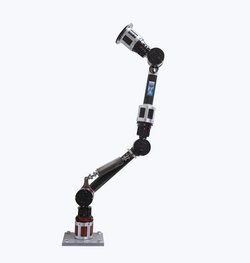COMPI
Compliant Robot Arm
Technical Details
System description
The robotic arm COMPI is composed of six rotational joints. Each of them is controlled by a FPGA, which implements different control modes. In particular, this system is used as platform to research dynamic control approaches. Such control strategies play an important role for force- or torque-based tasks, e.g. in the field of Human-Robot-Interaction. The obtained results are continuously transferred to other robotic systems, which have similar kinematic structures as sub-system.
The different modes for the joint control of position, velocity and current allow various high-level control strategies for the arm. Mode-switching and reconfiguration is possible during runtime. The limitation of all joint control variables is ensured in every mode. In addition, friction identification and compensation is implemented on the FPGA. A torque-based high-level controller then uses an identified dynamic model of the arm to compensate for non-linear effects such as gravity. This allows to control compliantly.
Publications:
Videos
COMPI: Robot arm with compliant control
Compliant trajectory tracking via model-based control allows human-robot interaction.
HySociaTea: Selected features from the final project demonstration
This video shows selected technologies of the HySociaTea scenario: the any-time resource planner, the object recognition using the information from the eye tracker, speech interaction with the robots and the virtual character, autonomous task allocation of the robots and autonomous robot-robot interaction.
HySociaTea: Autonomous robot-robot collaboration of Compi and AILA
This video shows the autonomous robot-robot collaboration in HySociaTea using the TECS framework. The Compi robot takes item to be delivered and reports that a delivery is required. AILA recognizes that she can handle the task and takes over. The handover is realized using a communication protocol.
HySociaTea: Customized Packaging Scenario
The Video illustrates the first demo setting and procedure with the Hybrid Team.
Intrinsic interactive reinforcement learning: Using error-related potentials
Thanks to human negative feedback, the robot learns from its own misconduct.

